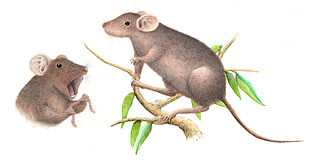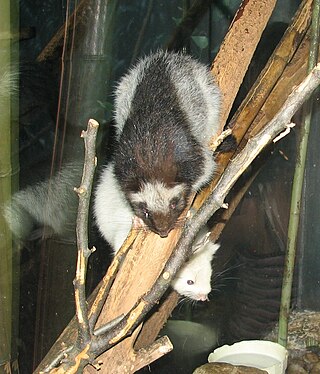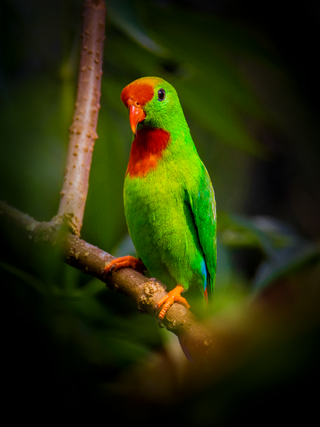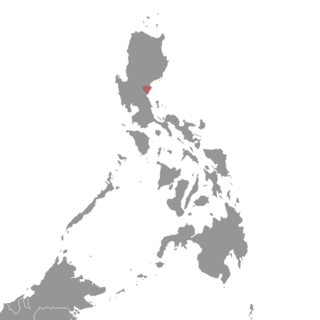
Apomys, commonly known as earthworm mice, is a genus of rodent endemic to the Philippines. Mice belonging to this genus are generally called Philippine forest mice and can be found on most islands of the Philippines except in Palawan, the Sulu Archipelago, and the Batanes and Babuyan group of islands.

Batomys is a genus of rodent endemic to the Philippines. It has six extant described species.

The Philippine deer, also known as the Philippine sambar or Philippine brown deer, is a vulnerable deer species endemic to the Philippines. It was first described from introduced populations in the Mariana Islands, hence the specific name.

The cloud rats or cloudrunners are a tribe (Phloeomyini) of arboreal and nocturnal herbivorous rodents endemic to the cloud forests of the Philippines. They belong to the family Muridae and include five genera: Batomys, Carpomys, Crateromys, Musseromys, and Phloeomys. They range in size from as large as 50 cm (20 in) to as small as 74 mm (2.9 in). Cloud rats are threatened by habitat loss and illegal hunting. Several species are endangered or critically endangered.

The Luzon montane forest mouse is a species of rodent in the family Muridae, from the genus Apomys. It occurs only in the Philippines, where it has been found on the large northern island Luzon. It is most closely related to the large Mindoro forest mouse, which occurs on Mindoro. There may be another related species in the Sierra Madre, but this species is yet undescribed. The Luzon montane forest mouse is a relatively large, ground-dwelling rat with a tail that is quite short for its genus.

The large Mindoro forest mouse is a species of rodent in the family Muridae, from the genus Apomys. It is found only in the Philippines. Its natural habitat is subtropical or tropical moist montane forests. It is a large mouse with large feet, a long tail and an elongated snout which is morphologically unique within its genus. It is covered in soft fur which is mostly dark brown in colour. Its closest relative is thought to be the Luzon montane forest mouse, based on genetic and morphological similarities.

The Mindanao montane forest mouse is a species of rodent in the family Muridae. It is found only in the Philippines.

The Philippine hanging parrot, also commonly known as the colasisi from its local Tagalog name "kulasisi", is a small psittaculid parrot species endemic to the Philippines. It includes about eleven subspecies, at least one of which might represent a distinct species, although further research is needed. While it is listed as Least Concern in IUCN, some subspecies, such as L. p. chyrsonotus of Cebu and L. p. siquijorensis of Siquijor, may already be extinct. The species is threatened by habitat loss, but a bigger threat is trapping for the illegal wildlife trade; wild-caught birds are often sold as pets in streets and online selling groups.

The Mindanao pygmy fruit bat is a species of megabat in the family Pteropodidae. It is the only species within the genus Alionycteris. It is endemic to the Philippines. Its natural habitat is subtropical or tropical dry forests at high elevations that are either scarce or overtaken by tourist hotspots. As a result, this species may be seeking new elevated habitats likely in the southern region of the Philippines and along the islands of Sulawesi.

The Katanglad shrew-mouse, also known as the Kitanglad shrew-mouse is a species of rodent in the family Muridae. It is known only from one specimen taken at 2250 m on Mount Kitanglad, Bukidnon Province, Philippines.
Danilo S. Balete, also known as Danny Balete, was a Filipino zoologist and biologist. His is known for his work on the Philippines' endemic mammal species. He pursued the question of what determines species diversity. The research by Balete and his team overturned previously held notions that diversity decreased in mountainous regions, showing that harsh environments could generate, rather than suppress, species diversity.
Lawrence Richard Heaney is an American mammalogist, ecologist and biogeographer. His research focus is the mammals of the Philippines.

The Luzon giant forest mouse is a forest mouse endemic to Luzon, Philippines.

The Luzon Aurora forest mouse is a forest mouse endemic to Aurora in Luzon, Philippines.

The Sierra Madre forest mouse is a forest mouse endemic to the Sierra Madre Range of eastern Luzon, Philippines.

The Luzon Zambales forest mouse is a forest mouse endemic to Zambales in Luzon, Philippines.

The Mount Mingan forest mouse is a forest mouse endemic to Mount Mingan in Luzon, Philippines.

The Mount Irid forest mouse is a forest mouse endemic to Mount Irid in Luzon, Philippines.

The Lubang forest mouse is a forest mouse endemic to Lubang Island in the Philippines.

















